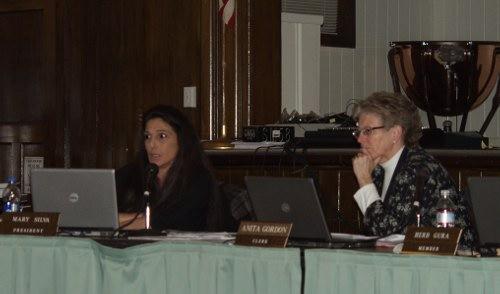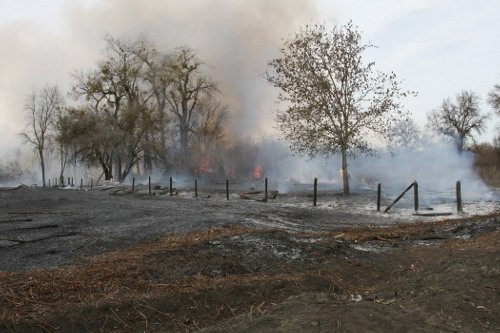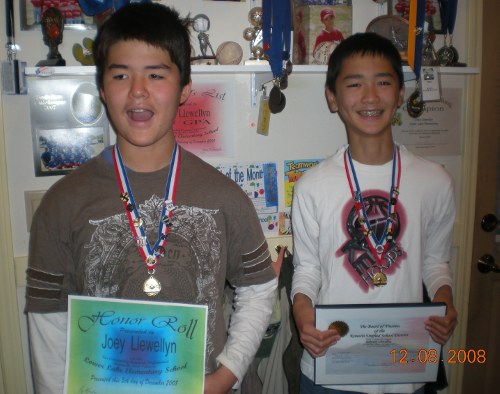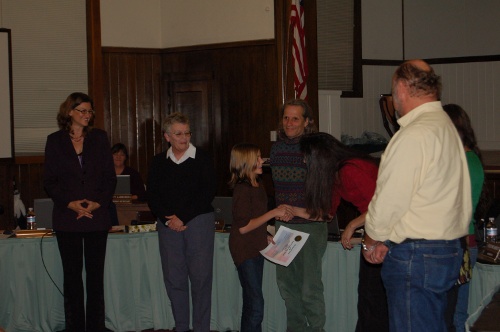
Konocti Unified Board President Mary Silva (left) and Board Clerk Anita Gordon during the Wednesday night board meeting, during which possible school closures were discussed. Photo by Elizabeth Larson.
LOWER LAKE – Facing the prospect of a $1 million budget cut next year and the year after, the Konocti Unified School District Board of Trustees is taking a hard look at potentially painful measures to keep the district afloat, including the possibility of closing some schools. {sidebar id=119}
About 60 people – parents, teachers and classified staff – attended the Wednesday evening board meeting at the district office in Lower Lake to hear the recommendations of two groups, the Committee on Consolidation of Services and the Attendance and Enrollment Revenue Improvement Committee.
The district's board formed the committees in October and tasked them with finding ways to save on expenses and increase revenue, respectively.
Bill Cornelison, the retired Lake County Office of Education superintendent, headed up the services consolidation group, whose membership included district, county and city officials, plus representatives from the office of education and Yuba Community College.
“The district, like all districts in California, is facing severe budget deficits and budget challenges, not only for the coming year but also for the present year,” said Cornelison, noting that the full implications of those budget issues aren't yet known.
In a half-hour presentation, Cornelison offered the group's recommendations in several areas – transportation services, nutritional services, cooperative endeavors with local government, and grade realignment and school closure.
Cornelison said the group came together with open minds, focusing on benefits for students, possible savings, impacts on certified and classified staff, and possible community reaction.
The recommendations for most of the service-oriented areas of study included joint purchasing with other governmental entities in the county, shortening bus routes, a central cafeteria location, coordination of recreation programs for children, having technology staff review ways to save money, and joint grounds and maintenance.
But it was the recommendations about possible school closures and realignment of grades that drew the most attention.
“This is not a pleasant task to talk about,” Cornelison said.
School closures have been talked about around the state, evoking a great deal of emotion and personal feelings, which Cornelison said the committee tried to take into account.
The committee eventually came up with a total of 10 proposals, which they narrowed to four, Cornelison said.
Those recommendations were as follows:
Close Oak Hill Middle School (473 students) and change Pomo, Burns Valley and Lower Lake Elementary schools into K-8; potential cost savings, $400,000 to $968,000.
Operate four K-8 schools with East Lake Elementary (195 students) closing; potential cost savings, $0 to $250,000.
Konocti Unified's board will hold public hearings throughout the district to give the community an opportunity to weigh-in on the alternatives, said Cornelison (see sidebar story, “Public meetings on school closure proposals”).
On the other side of the coin, Dr. Nancy Todd chaired the revenue committee.
She said she believed they could bring in more than $1.5 million if all students came to school every day and they gained back interdistrict transfers.
“When you have these awful weighty decisions to make, it's good to remember your strengths,” Todd said, lauding the district for its successful efforts in the past to deal with social and funding issues.
Committee recommendations include convening a standing committee to deal with attendance; involving teachers, parents and older students in understanding the revenue increase that comes with student attendance; create incentives for sites and students to improve attendance rates; designating someone to work with the media and other visual reminders of progress.
The committee's suggestions also included motivating students by letting them earn units for work satisfactorily done, rather than semesters; publicizing student success; offering specialty courses in trades, technology and health care; and investigating what's involved with shifting to operating K-8 schools and a high school.
Todd said she hoped the the conversation leaves the public with the impression that, despite the district having to make cuts, children are left at the center of the process and the community is respected.
Community members, teachers against closing schools
Glen Goodman, the librarian of Lower Lake High School, said the approach to the district's budget issues starts with the assumption that enrollment is going down, but he said he expects to see just the opposite as more people move to Lake County because of its affordable housing.
He suggested that if the district closes schools, it also needs to factor in the cost of reopening them once enrollment starts to go up again.
The people most likely to decide to take their children out of the district because of school closures are those parents who are most involved, and whose students do the best in school. That, he said, could impact the district's test scores.
He suggested a progressive approach to education, much like he sees at Carle High School, which could attract students.
“This is a monstrous project that we're considering embarking on, and I think it's based on old information, declining enrollment,” he said. “I think the best bet for us is to just forge ahead with making a better education.”
Parent Cale Page said he's against school closures. He said his daughter told him she was treated as the person she wanted to be, not the person she was, at her school. As a result, she's doing well in school, where Page said the teachers do a great job.
If district leaders are wondering what kind of student they would lose by closing schools, it would be his daughter, said Page.
Oak Hill Middle School teacher Bill Meyer asked Superintendent Bill MacDougall if he was wiling to reject the school closures recommendation if the state went in a positive direction.
“The answer is absolutely,” said MacDougall.
Dana Moore, the district's director of maintenance and operations, said the district is looking at 18 empty classrooms and a midyear cut of between $850,000 and $1.2 million, with more possibly to come next fiscal year.
There hasn't been any talk of more money coming to the schools, and none of the prospects look good. “And that's why we're here,” Moore said.
Carle High School teacher Angie Siegel said she spent 10 years as a middle school teacher, including several years at Oak Hill Middle School, where she said the staff has worked hard for the students.
She said middle schools are much maligned. “The real issue is puberty,” she said, explaining that children are going through a lot of changes.
“I'm a big believer in middle school,” she said. “They're a special breed of cat.”
Oak Hill Middle School teacher Paul Leiferman, who also is president of the Konocti Education Association, said he has been a middle school teacher for more than 30 years – “by choice,” he emphasized – and he agreed with Siegel that a lot of work has been done at the school.
He said he deals with some of the toughest kids in the county, and has about 20 in his classroom who the district wouldn't want near fourth and fifth graders.
The No. 1 most important issue should be what's best for the kids, and are they prepared when they get to the high school, he said.
Board offers its perspective
Board members assured the audience that they wanted to make the best choices for the district and its students.
“Our main concern is the students and doing right by our students,” said Board President Mary Silva.
Trustee Herb Gura said he had no idea how he would vote, but that recommendations from the committees were only one factor he would consider. “It matters to me a lot how this affects students and families and staff.”
He admitted the district is facing a very scary situation, but noted that the district has been careful in its spending, which he credited to district chief business officer Laurie Altic.
“So just hang in there and we'll see what happens,” he said. “I don't have any answers at this point, either.”
Another board member, Hank Montgomery, said he's a big fan of middle school, and credited Oak Hill Middle School with helping his children be successful.
He emphasized that the board has made no decision yet, and said he doesn't feel limited by the committees' recommendations.
The closure of schools ultimately rests with the board, said Montgomery, which is why they're planning to hold meetings around the district in an effort to get input.
Everything is on the table, and nothing is sacred when it comes to looking for ways to make ends meet, said Montgomery.
He said the discussion of consolidating other services across – while not as controversial – also is significant, Montgomery said. “This board began discussing this years ago.”
The board had directed Dr. Louise Nan, the former superintendent, to discuss that idea with other districts, Montgomery said. “No one would listen, no one would even entertain that.”
He added that the board believes consolidating services is consistent with the district's philosophy that cuts happen as far away from the classroom and students as possible.
Board Clerk Anita Gordon agreed with Montgomery. She added that she's extremely frustrated by what's happening in Sacramento with the state Legislature and the state budget. There's nothing citizens can do but live with those decisions that come from the state.
“And you're seeing that tonight,” she said.
Board member Carolynn Jarrett referred to a list of ideas that came from the board's Jan. 24 budget workshop, which summarize what they want for the schools. The overriding goal stated in that document was that all students graduate from the K-12 system, with intervention, safety, class size reduction and classroom personnel – the first priority, and last to be cut – listed among the priorities.
She said the district is trying to preserve the quality programs it has. Jarrett said the district had to cut $1 million last year, and they have may to cut $1 million next year and again the year after.
“On March 11 we are going to have to make a decision, because we cannot continue the status quo,” Jarrett said. “We have to come up with something different.”
To see the committees' full recommendations, visit the Konocti Unified School District Web site, www.konoctiusd.lake.k12.ca.us/2009budgetadvisory/.
E-mail Elizabeth Larson at This email address is being protected from spambots. You need JavaScript enabled to view it..
{mos_sb_discuss:3}

 How to resolve AdBlock issue?
How to resolve AdBlock issue? 















